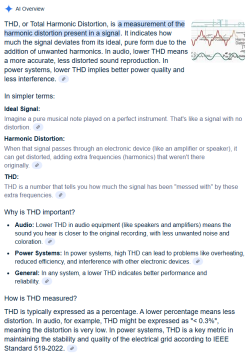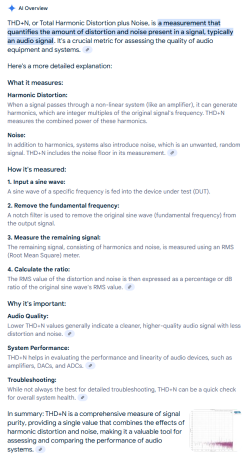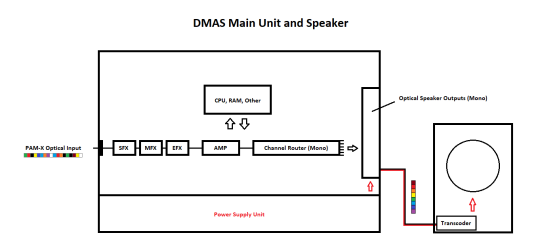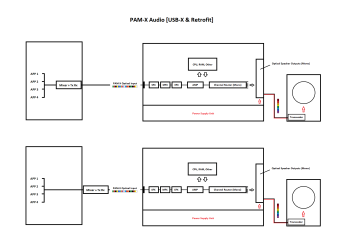-
Welcome to TechPowerUp Forums, Guest! Please check out our forum guidelines for info related to our community.
You are using an out of date browser. It may not display this or other websites correctly.
You should upgrade or use an alternative browser.
You should upgrade or use an alternative browser.
DTS DCH Driver for Realtek HDA [DTS:X APO4 + DTS Interactive]
- Thread starter Ferather
- Start date
- Joined
- Dec 8, 2020
- Messages
- 3,237 (1.92/day)
- Location
- United Kingdom
As soon as the DMAS or similar comes out, power based signal and binary will become redundant in terms of audio and video transmission.
The same can be said for compression and encoding methods, none can match optical, in a perfect scenario.
Processing parts will likely cost the most, such as the DSP (SoC) and other required components.
The price of the technology will go down in time as demand increases.
----
In theory, while optical 1 bit PAM-X is digital, it also counts as an analogue of sound, if the resolution is high enough (also less parts).
Since the method counts as position-to-position in terms of microphone and speaker, its direct digital.
In short, you can map each position a microphone can be in, in colour value, opposed to long lengths of 0 and 1.
Long lengths of 0 and 1 birthed compression, which is to represent long lengths of 0 and 1.
Binary, lets say 24 x 0 and 1 pulses, is bloated compared to 1 colour pulse.
----
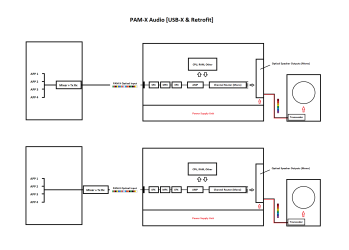
The mixer part is drawn simply, mixing is at point.
----
The same can be said for CPU and GPU processing and transmission technology, where colour value replaces binary for switch operation.
Operation is more simplified, as all switches are in the off state, until a colour pulse is received (or colour pulses).
RGB produces 16,777,216 values (equal to 24 bit binary), each value represents a switch, 1 bit.
====
Fun fact, if you did an equal 24 pulses to 1 bit time, RGB (1 audio position), that would be 16,777,216^24 values (silly number).
2^24 = 16,777,216 | Binary values ^ bits used.
----
1 bit PAM-X (1:1) is 24 times more efficient than 24 bit binary.
The same can be said for compression and encoding methods, none can match optical, in a perfect scenario.
Processing parts will likely cost the most, such as the DSP (SoC) and other required components.
The price of the technology will go down in time as demand increases.
----
In theory, while optical 1 bit PAM-X is digital, it also counts as an analogue of sound, if the resolution is high enough (also less parts).
Since the method counts as position-to-position in terms of microphone and speaker, its direct digital.
In short, you can map each position a microphone can be in, in colour value, opposed to long lengths of 0 and 1.
Long lengths of 0 and 1 birthed compression, which is to represent long lengths of 0 and 1.
Binary, lets say 24 x 0 and 1 pulses, is bloated compared to 1 colour pulse.
----

The mixer part is drawn simply, mixing is at point.
----
The same can be said for CPU and GPU processing and transmission technology, where colour value replaces binary for switch operation.
Operation is more simplified, as all switches are in the off state, until a colour pulse is received (or colour pulses).
RGB produces 16,777,216 values (equal to 24 bit binary), each value represents a switch, 1 bit.
====
Fun fact, if you did an equal 24 pulses to 1 bit time, RGB (1 audio position), that would be 16,777,216^24 values (silly number).
2^24 = 16,777,216 | Binary values ^ bits used.
----
1 bit PAM-X (1:1) is 24 times more efficient than 24 bit binary.
Last edited:
- Joined
- Dec 8, 2020
- Messages
- 3,237 (1.92/day)
- Location
- United Kingdom
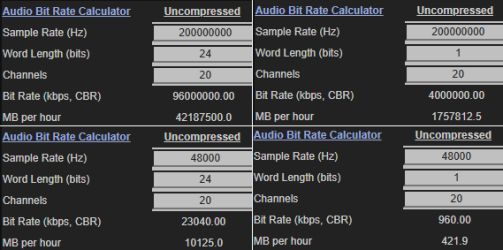
1 bit PAM-X, 20 channels, for 48k sample rate just under 1 Mbits/s.
48 Kbits/s per channel (sample rate), x number of channels.
960 x 24 = 23,040 | 24 times more efficient.
----
Equal bit time, and additional pulses, 48 bit = 48 times more efficient.
====
Reminder 1: Sample rate, and audio bandwidth are two separate things.
Reminder 2: The higher the sample rate, the more accurate the audio.
Reminder 3: Less parts are needed when using a higher sample rate.
Reminder 4: The higher the bit value, the more accurate the audio.
Last edited:
- Joined
- Dec 8, 2020
- Messages
- 3,237 (1.92/day)
- Location
- United Kingdom
Just so you know, the upmixer preset has essentially a brickwall filter for PCM, which attenuates audio frequencies above 20kHz (outside of human hearing range).
If you enable-disable the low pass filter in the main 'Config' tab, you should notice a difference, funnily enough enabled = less THD+N.
This can be explained by the way hardware deals with audio frequencies and filtering, so we add a pre-filter (digital).
In theory, the audio should be resampled, allowing each sample to represent only up to 20kHz.
When using 48kHz sample rate, you will get more samples than 44.1kHz...
If you enable-disable the low pass filter in the main 'Config' tab, you should notice a difference, funnily enough enabled = less THD+N.
This can be explained by the way hardware deals with audio frequencies and filtering, so we add a pre-filter (digital).
In theory, the audio should be resampled, allowing each sample to represent only up to 20kHz.
When using 48kHz sample rate, you will get more samples than 44.1kHz...
https://www.mediafire.com/file/dnmxwbqavexfoyk/Win_CAudio.7z (Made with Win10).
Disables some Windows APO's that cause THD, THD+N.
----
Attachments
Last edited:
- Joined
- Dec 8, 2020
- Messages
- 3,237 (1.92/day)
- Location
- United Kingdom
Audio (from app) > Software DSP's [Windows DSP's > Spatial DSP > SFX > MFX > EFX] (32 Bit Float) > Hardware > Speaker.
As close as you will get, to a DMAS in terms of digital out, and a Realtek. DSP = Digital Signal Processor.
DTS Digital Surround, uses 32 bit float in compression, so to Z906 it should be 32 bit float to 48 bit > 200 MHz.
====
1 bit PAM-X (1 pulse a bit) is 24 x more efficient than 24 bit binary, 2 pulses a bit, 48 x more efficient than 48 bit, so on.
1 bit per sample so 200 MHz is 200 Mbits/s. Clocking and calculations are done in bit time, and pulse rate.
====
Wont be long for 1 bit PAM-X or similar to hit GPU technology:
NVIDIA Announces Spectrum-X Photonics, Co-Packaged Optics Networking Switches to Scale AI Factories to Millions of GPUs
----

Increasing video resolution increases video quality, increasing audio resolution increases audio quality, both facts.
Pulse rate can be used to increase bit value, or the number of samples (frames) per second.
====
As close as you will get, to a DMAS in terms of digital out, and a Realtek. DSP = Digital Signal Processor.
DTS Digital Surround, uses 32 bit float in compression, so to Z906 it should be 32 bit float to 48 bit > 200 MHz.
====
1 bit PAM-X (1 pulse a bit) is 24 x more efficient than 24 bit binary, 2 pulses a bit, 48 x more efficient than 48 bit, so on.
1 bit per sample so 200 MHz is 200 Mbits/s. Clocking and calculations are done in bit time, and pulse rate.
====
Wont be long for 1 bit PAM-X or similar to hit GPU technology:
NVIDIA Announces Spectrum-X Photonics, Co-Packaged Optics Networking Switches to Scale AI Factories to Millions of GPUs
----

Increasing video resolution increases video quality, increasing audio resolution increases audio quality, both facts.
Pulse rate can be used to increase bit value, or the number of samples (frames) per second.
====
Attachments
Last edited:
- Joined
- Dec 8, 2020
- Messages
- 3,237 (1.92/day)
- Location
- United Kingdom
If RGBV was used and 'V' is equal to 256 values, then 256^4 [256(R) x256(G) x256(B) x256(V)], and each 'single' pulse is equal to 32 bit binary (32 x 0/1 pulses, 2^32).
Photonic superposition digital is superior to binary digital in every manner, it also removes the need for power based signals where possible.
Yes we still use numbers to build and calculate data and transmission, bits, bits data, not power signal.
====
When the DMAS or similar comes out, be sure to buy the DTS version, the firmware can be updated if the OEM builds it that way.
If 1 bit PAM-X is used fully to the speaker, the audio processing and resulting quality with be unmatched.
Also lets not forget about 3D bits and spatial channels, at full specification.
----
Also note my 1 bit PAM-X method, is not copyrighted nor requires a license to use, so feel free to use or adapt it to suit.
====
Sample rate translation, each bit RGB is equal to 24 binary pulses (24 bit) in values, so each sample is 1 bit (1 pulse) RGB.
In this case, it becomes bit rate (not Hz), which is independent, or equal to, the pulse rate (PAM-X).
Photonic superposition digital is superior to binary digital in every manner, it also removes the need for power based signals where possible.
Yes we still use numbers to build and calculate data and transmission, bits, bits data, not power signal.
====
When the DMAS or similar comes out, be sure to buy the DTS version, the firmware can be updated if the OEM builds it that way.
If 1 bit PAM-X is used fully to the speaker, the audio processing and resulting quality with be unmatched.
Also lets not forget about 3D bits and spatial channels, at full specification.
----
Also note my 1 bit PAM-X method, is not copyrighted nor requires a license to use, so feel free to use or adapt it to suit.
====
Sample rate translation, each bit RGB is equal to 24 binary pulses (24 bit) in values, so each sample is 1 bit (1 pulse) RGB.
In this case, it becomes bit rate (not Hz), which is independent, or equal to, the pulse rate (PAM-X).
Last edited:
- Joined
- Dec 8, 2020
- Messages
- 3,237 (1.92/day)
- Location
- United Kingdom
If you went as far as 64 bit word PCM, then 1 bit PAM-X is 64 times more efficient than binary pulses (NRZ).
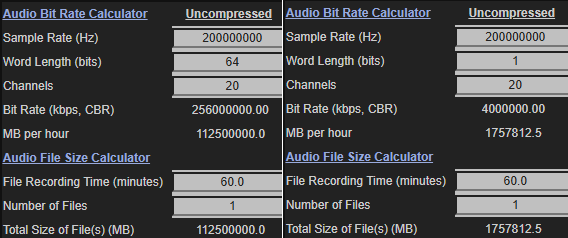
4000000 (image 2) x 64 = 256,000,000 (image 1). Efficiency grows as binary grows.
That's full data in one bit, not 64 pulses equals 1 bit potential (data, 1 sample).
====
RGBV (256^4) = 32 bit values, 2 pulse to 1 bit time = 64 bit.
4,294,967,296^2 == 2^64, but the same bit time as 32 bit.
RGB | 256^3 (single pulse) == 2^24

4000000 (image 2) x 64 = 256,000,000 (image 1). Efficiency grows as binary grows.
That's full data in one bit, not 64 pulses equals 1 bit potential (data, 1 sample).
====
RGBV (256^4) = 32 bit values, 2 pulse to 1 bit time = 64 bit.
4,294,967,296^2 == 2^64, but the same bit time as 32 bit.
RGB | 256^3 (single pulse) == 2^24
Last edited:


